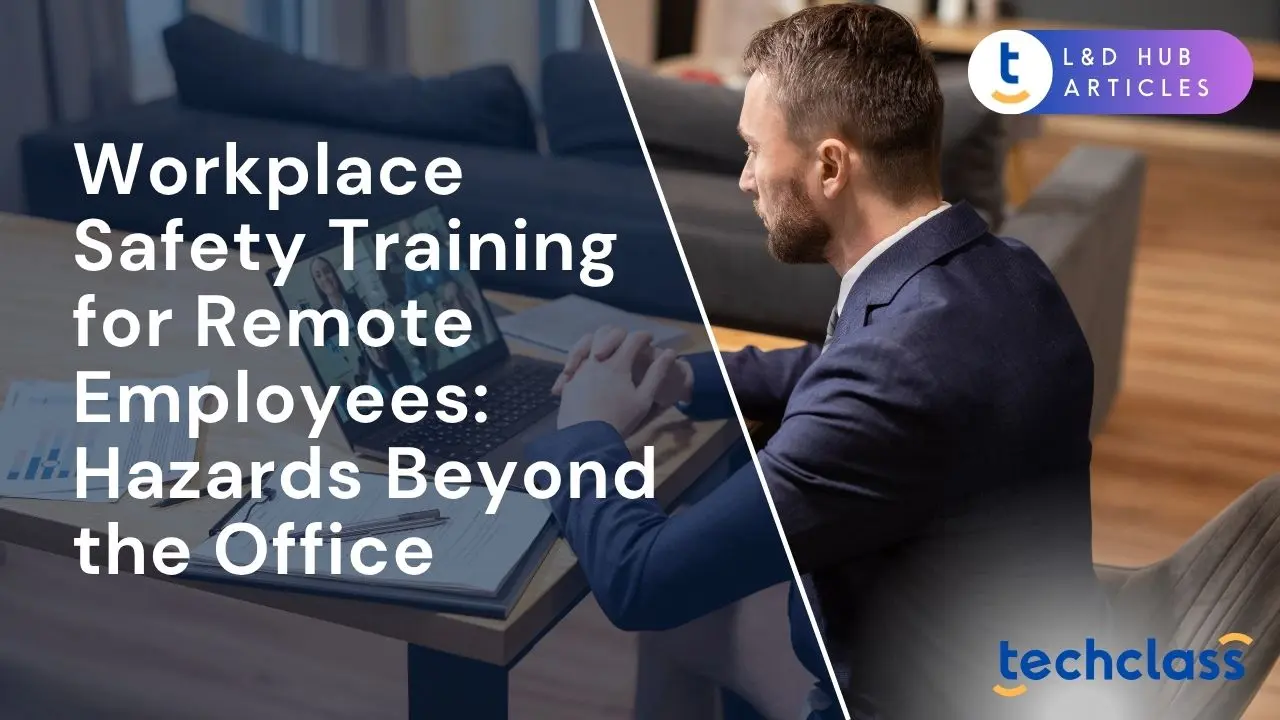
The rise of remote work has transformed how organizations approach employee safety. Millions of people now work from home or other off-site locations, a trend accelerated by the global pandemic and sustained by evolving work culture. With an estimated majority of remote-capable employees working either fully remotely or in hybrid arrangements, the traditional office is no longer the only “workplace.” This shift brings new safety challenges that extend beyond the controlled environment of an office. HR professionals and business leaders must recognize that their duty of care to employees covers any location an employee works, whether it's a corporate cubicle or a home office. Ensuring workplace safety for remote employees requires adapting training and policies to address hazards outside the office. This article explores the unique risks remote workers face and how effective safety training can help mitigate those hazards, creating a safer and healthier remote workforce.
Workplace safety isn’t confined to factory floors or office buildings, it extends to wherever employees carry out their duties. Employers have a responsibility to provide a work environment “free from recognized hazards,” and this holds true even when the work environment is a home office. In many jurisdictions, firms retain a duty of care for remote staff similar to on-site staff. Notably, a German court ruling in 2021 underscored this point when it deemed an employee’s fall on the walk from his bed to his desk (in his home) a workplace accident eligible for workplace insurance coverage. This example illustrates that injuries occurring “beyond the office” can still be considered work-related, reinforcing why proactive safety measures for remote workers are essential.
From a legal and ethical standpoint, organizations cannot afford to ignore remote work hazards. Even if safety regulators (such as OSHA in the U.S.) do not routinely inspect home offices or hold employers accountable for every aspect of an employee’s home, employers are still expected to educate and equip employees to work safely. Beyond compliance, there’s a clear business case: injuries or health issues sustained by remote employees can lead to lost productivity, medical costs, and decreased morale. For instance, if an employee develops chronic back pain due to an improper home workstation, they may require time off or reduced duties, impacting both the individual and the company. Effective safety training for remote staff helps prevent such outcomes by raising awareness of hazards and how to control them. In short, safety training tailored to remote employees matters because it protects the workforce, reduces liability, and fosters a culture of well-being no matter where work is done.
One of the most prevalent challenges for remote employees is setting up a healthy, ergonomic workspace outside the structured office environment. Before remote work became commonplace, companies often invested heavily in ergonomic office furniture and workstation assessments to prevent musculoskeletal disorders (MSDs). Those efforts were well-founded, roughly 30% of all workplace injuries resulting in days away from work are related to musculoskeletal issues like back pain and carpal tunnel syndrome. In a home setting, however, employees might be working from kitchen tables, couches, or makeshift desks not designed for prolonged computer use. This can lead to neck and shoulder strain, lower back pain, eye strain, and repetitive motion injuries over time.
Studies have highlighted the scope of the problem. In 2020, a World Economic Forum survey found 46% of remote workers struggled to get work done due to an improper setup or inadequate equipment. Another study by ergonomics researchers noted that over 80% of telecommuters reported physical discomfort stemming from suboptimal home office setups. Clearly, poor ergonomics is a widespread hazard “beyond the office.” Employees might slouch on a sofa with a laptop or use a chair without back support, not realizing these habits can cause cumulative injuries.
Workplace safety training for remote staff must emphasize ergonomics. Employers should provide guidelines on proper workstation arrangement, for example, using an adjustable chair, positioning the monitor at eye level an arm’s length away, keeping wrists straight when typing, and taking regular stretch breaks. Some organizations have addressed this hazard by offering remote workers stipends or equipment packages to acquire ergonomic desks, chairs, or accessories. In fact, several companies gave their at-home employees up to $1000 to outfit home offices with appropriate furniture. Even without lavish budgets, simple training and resources can help: interactive online modules or checklists can teach employees how to self-assess their posture and workspace. The goal is to recreate, as much as possible, the safety and comfort of a well-designed office workstation at home. By reducing physical strain, businesses not only prevent injuries but also improve remote worker productivity and comfort.
Outside of a traditional office, employees may be exposed to everyday household hazards that can interfere with safe working. A home may seem innocuous, but it lacks the standardized safety controls of a corporate workplace. One major concern is electrical safety. In an office, electrical setups are typically handled by professionals, outlets are commercial-grade and equipment is configured to avoid overloading circuits. At home, a remote worker might plug multiple high-wattage devices (computers, monitors, printers, chargers) into a single power strip or extension cord. This creates a risk of overheating or even fire. The National Fire Protection Association has reported over 32,000 home fires annually in recent years caused by faulty electrical distribution and lighting equipment. With the surge in at-home work and increased use of electrical devices all day, experts fear this number could climb further. Safety training should therefore remind remote employees to use surge protectors, avoid daisy-chaining extension cords, and not overload outlets. Additionally, basic precautions like ensuring smoke detectors are working in the home office area and having a fire extinguisher handy are wise practices to encourage.
Another set of hazards involves slips, trips, and falls in the home workspace. Offices are usually designed with clear walkways, cable management, and ergonomic layouts. By contrast, home offices can be improvised corners of living rooms or bedrooms where tripping hazards abound. Trailing laptop cords across a hallway, cluttered floors with boxes or children’s toys, or even area rugs on hardwood floors can all pose dangers. A remote employee rushing to answer a work call could trip over a loose cable or, as one real example shows, even the family dog. (In OSHA recordkeeping, an injury from tripping over a pet while working wouldn’t count as “work-related”, but it’s certainly a painful setback for the employee.) To mitigate these risks, employees should be trained to keep their designated work area tidy and safe: secure or tape down cords along walls, remove obstacles from their walking paths, and ensure adequate lighting to prevent stumbles. Employers can support this by providing a home office safety checklist, for instance, prompting workers to verify that floors are clear, carpets are flat, and frequently used items are within easy reach to avoid overextension.
Finally, remote workers should be mindful of general home safety as part of their workday. Unlike an office, there’s typically no on-site facilities team to respond to spills, maintenance issues, or other dangers. Thus, training can cover simple preventative measures: ergonomics (addressed above), fire prevention (unplug devices when not in use, do not block exits), and even safe storage of work materials (heavy files or equipment should be on sturdy shelves to avoid tip-overs). By ingraining these habits, employers help remote staff create a workspace that is not just comfortable but also physically safe. A few preventive steps can greatly reduce the chance of a home accident interrupting one’s work, or causing a serious injury.
Beyond the immediate physical risks, remote work can introduce psychosocial hazards that are just as important to address through training and awareness. Working in isolation, away from colleagues, in an environment that doubles as one’s personal space, can blur boundaries and take a toll on mental well-being. Loneliness, stress, and burnout have emerged as significant concerns in the remote workforce. A survey by the American Psychiatric Association found that nearly two-thirds of U.S. remote workers reported feeling isolated or lonely at least occasionally while working from home, and about 17% said they felt that way often or all the time. Humans are social creatures, and the casual interactions and support systems present in a physical workplace are harder to replicate through a screen.
Moreover, the lack of separation between work and home life in remote settings can lead to overwork. Many employees struggle with “always on” syndrome, checking emails late at night, or unable to unplug because their office is at home. This can contribute to chronic stress and burnout. Microsoft, for example, noted a significant increase in employee burnout rates during the height of the pandemic, with a large segment of their remote staff feeling more exhausted than before. In a broader 2021 study on mental health, an astonishing 76% of employees reported experiencing at least one symptom of a mental health condition (such as anxiety or depression) in the prior year, underscoring how widespread these challenges are.
Why are mental health issues considered a workplace safety topic? Because poor mental health can directly impact an employee’s ability to work safely and effectively. Depression and anxiety can lead to distraction, errors, or decreased motivation. The CDC estimates that depression results in about 200 million lost workdays each year, costing employers billions in lost productivity. Additionally, extreme stress can manifest physically (sleep problems, high blood pressure) and increase the risk of accidents or health crises. It’s in an employer’s interest, and part of their duty of care, to promote psychological safety and support for remote workers, just as they would address physical safety.
To tackle these hazards, companies are increasingly weaving mental health into their safety training and wellness programs. Managers should be trained to recognize signs of burnout or isolation in their remote team members, for instance, if someone becomes uncharacteristically unresponsive, irritable, or starts missing deadlines, it may signal deeper issues. Employers can provide resources such as Employee Assistance Programs (EAPs), counseling services, or subscriptions to mental health apps for those who need support. Some forward-thinking organizations have implemented mandatory time-off policies or “burnout breaks.” A well-known example is LinkedIn, which gave its entire workforce a paid week off to recharge and combat burnout. Other companies encourage regular virtual coffee chats or team-building activities to replace some of the social interaction lost in remote work. Safety training for remote employees should include tips on maintaining work-life balance (e.g. setting a routine, having a designated workspace that you can step away from after hours) and stress management techniques. By acknowledging and addressing mental health as a key component of workplace safety, employers help ensure that their remote staff stay healthy, engaged, and productive.
When considering “hazards beyond the office,” one must also account for digital risks that remote employees face. While cybersecurity might not be a traditional occupational safety topic, it has become an essential part of the remote work environment. A data breach or cyber incident can jeopardize a company’s operations and an employee’s job security, and it often comes with significant stress and financial costs. Remote workers often access sensitive company systems via home networks that may be less secure than in-office setups. According to a report by Cybersecurity Insiders, about 70% of organizations experienced an increase in security threats or attacks during the shift to remote work, as hackers attempted to exploit vulnerabilities in home Wi-Fi networks and personal devices. This escalation in cyber threats means that remote employees need to be trained on digital safety practices just as they are trained on physical safety.
Key topics to cover include: using strong, unique passwords and multi-factor authentication for all work accounts; ensuring the home Wi-Fi network is encrypted and password-protected; recognizing phishing emails and suspicious links; and using company-approved VPNs and security software when accessing work resources. For example, employees should know never to click on an unexpected email attachment without verification, and to regularly update their computer’s security patches. Additionally, remote work sometimes involves handling confidential documents outside the office, so workers should be instructed on data privacy, such as locking their screens when stepping away and securely disposing of any printed sensitive materials.
Cybersecurity training for remote staff can be delivered through short online modules or even simulated phishing tests that help employees practice good judgment. Emphasizing this aspect of safety protects both the individual (from identity theft or personal liability) and the organization (from costly breaches). As part of a comprehensive remote work safety program, treating “digital hazards” seriously cultivates a mindset that safety isn’t just about preventing physical accidents, but also about safeguarding information and technology assets. In an era where work and the internet are deeply intertwined, cyber vigilance is a skill every remote employee should develop as part of staying safe on the job.
Designing and implementing an effective safety training program for remote employees involves rethinking traditional approaches and embracing new strategies. Here are several best practices and considerations for HR and safety leaders:
Implementing these best practices requires effort and adaptation, but it pays off. Organizations that invest in safety training for remote employees typically see benefits like fewer health-related absences, higher employee satisfaction, and reduced workers’ compensation claims. Remote workers who feel cared for and equipped to work safely are likely to be more engaged and loyal as well. In essence, safety training beyond the office is an investment in your people that yields strong returns in well-being and productivity.
The shift to remote and hybrid work is one of the defining workplace changes of our time. With it comes the responsibility for employers to extend the umbrella of safety to wherever their employees are working. “Workplace” now truly means any place work happens. By proactively addressing hazards beyond the office, from ergonomic strains and home electrical risks to mental health and cybersecurity threats, organizations demonstrate a commitment to their employees’ holistic well-being. This not only helps prevent injuries and burnout, but also builds trust. Employees who see that their company cares about their home office setup or mental health feel valued, which can boost morale and performance.
For HR professionals and business leaders, the takeaway is clear: don’t treat remote staff as out of sight, out of mind when it comes to safety. Integrate remote workers into your safety culture. Provide them with the knowledge, tools, and support to stay safe and healthy in their unique work environments. Hazards beyond the office may be different from those on the factory floor, but they are equally important to manage. By educating remote employees and fostering open communication, companies can reduce accidents and health issues while empowering their teams to work confidently from anywhere.
Embracing safety beyond the office is about adaptation and awareness. As work evolves, so too must our approach to keeping people safe. With thoughtful training and a culture of care, employers can ensure that every employee, whether at headquarters or at home, has the foundation to thrive in a safe, productive, and supportive work environment.
Safety training for remote employees helps prevent injuries, ensures legal compliance, and promotes overall well-being regardless of location.
Remote workers often work from unsuitable furniture, leading to musculoskeletal issues like back pain, neck strain, and eye discomfort.
Risks include electrical overload, fire hazards, slips, trips, falls, and clutter that may cause accidents in the home workspace.
Organizations can provide resources like counseling, promote work-life boundaries, and encourage social interaction to combat isolation and burnout.
Use strong passwords, multi-factor authentication, secure Wi-Fi, recognize phishing attempts, and utilize VPNs to safeguard company data.

.webp)
